Farah E. Shamout
MedArabiQ: Benchmarking Large Language Models on Arabic Medical Tasks
May 06, 2025



Abstract:Large Language Models (LLMs) have demonstrated significant promise for various applications in healthcare. However, their efficacy in the Arabic medical domain remains unexplored due to the lack of high-quality domain-specific datasets and benchmarks. This study introduces MedArabiQ, a novel benchmark dataset consisting of seven Arabic medical tasks, covering multiple specialties and including multiple choice questions, fill-in-the-blank, and patient-doctor question answering. We first constructed the dataset using past medical exams and publicly available datasets. We then introduced different modifications to evaluate various LLM capabilities, including bias mitigation. We conducted an extensive evaluation with five state-of-the-art open-source and proprietary LLMs, including GPT-4o, Claude 3.5-Sonnet, and Gemini 1.5. Our findings highlight the need for the creation of new high-quality benchmarks that span different languages to ensure fair deployment and scalability of LLMs in healthcare. By establishing this benchmark and releasing the dataset, we provide a foundation for future research aimed at evaluating and enhancing the multilingual capabilities of LLMs for the equitable use of generative AI in healthcare.
Multimodal Deep Learning for Stroke Prediction and Detection using Retinal Imaging and Clinical Data
May 05, 2025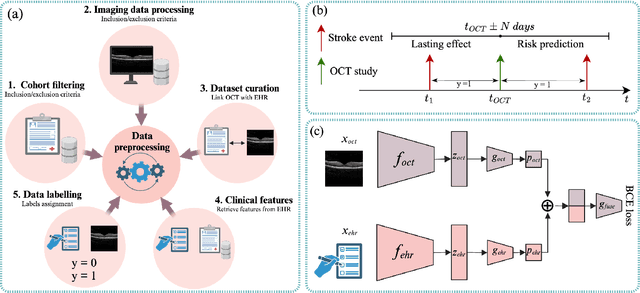
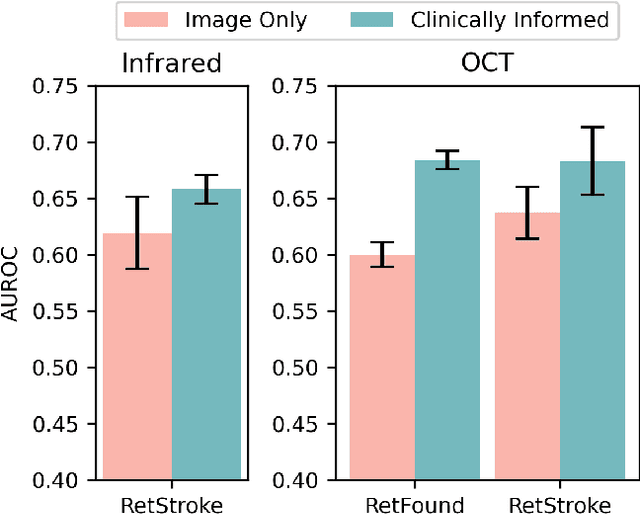
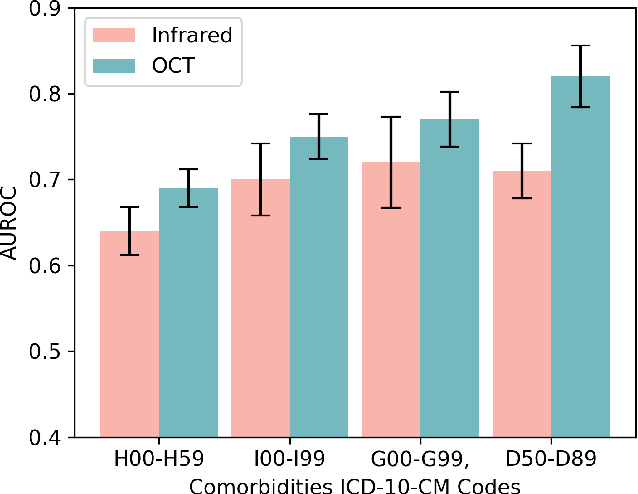
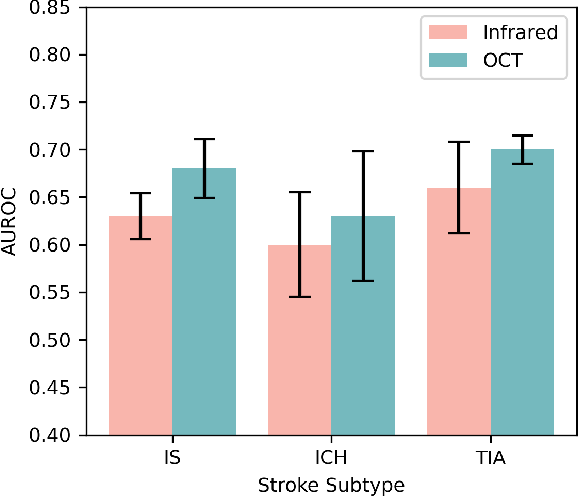
Abstract:Stroke is a major public health problem, affecting millions worldwide. Deep learning has recently demonstrated promise for enhancing the diagnosis and risk prediction of stroke. However, existing methods rely on costly medical imaging modalities, such as computed tomography. Recent studies suggest that retinal imaging could offer a cost-effective alternative for cerebrovascular health assessment due to the shared clinical pathways between the retina and the brain. Hence, this study explores the impact of leveraging retinal images and clinical data for stroke detection and risk prediction. We propose a multimodal deep neural network that processes Optical Coherence Tomography (OCT) and infrared reflectance retinal scans, combined with clinical data, such as demographics, vital signs, and diagnosis codes. We pretrained our model using a self-supervised learning framework using a real-world dataset consisting of $37$ k scans, and then fine-tuned and evaluated the model using a smaller labeled subset. Our empirical findings establish the predictive ability of the considered modalities in detecting lasting effects in the retina associated with acute stroke and forecasting future risk within a specific time horizon. The experimental results demonstrate the effectiveness of our proposed framework by achieving $5$\% AUROC improvement as compared to the unimodal image-only baseline, and $8$\% improvement compared to an existing state-of-the-art foundation model. In conclusion, our study highlights the potential of retinal imaging in identifying high-risk patients and improving long-term outcomes.
Uncertainty Quantification for Machine Learning in Healthcare: A Survey
May 04, 2025

Abstract:Uncertainty Quantification (UQ) is pivotal in enhancing the robustness, reliability, and interpretability of Machine Learning (ML) systems for healthcare, optimizing resources and improving patient care. Despite the emergence of ML-based clinical decision support tools, the lack of principled quantification of uncertainty in ML models remains a major challenge. Current reviews have a narrow focus on analyzing the state-of-the-art UQ in specific healthcare domains without systematically evaluating method efficacy across different stages of model development, and despite a growing body of research, its implementation in healthcare applications remains limited. Therefore, in this survey, we provide a comprehensive analysis of current UQ in healthcare, offering an informed framework that highlights how different methods can be integrated into each stage of the ML pipeline including data processing, training and evaluation. We also highlight the most popular methods used in healthcare and novel approaches from other domains that hold potential for future adoption in the medical context. We expect this study will provide a clear overview of the challenges and opportunities of implementing UQ in the ML pipeline for healthcare, guiding researchers and practitioners in selecting suitable techniques to enhance the reliability, safety and trust from patients and clinicians on ML-driven healthcare solutions.
MIND: Modality-Informed Knowledge Distillation Framework for Multimodal Clinical Prediction Tasks
Feb 03, 2025Abstract:Multimodal fusion leverages information across modalities to learn better feature representations with the goal of improving performance in fusion-based tasks. However, multimodal datasets, especially in medical settings, are typically smaller than their unimodal counterparts, which can impede the performance of multimodal models. Additionally, the increase in the number of modalities is often associated with an overall increase in the size of the multimodal network, which may be undesirable in medical use cases. Utilizing smaller unimodal encoders may lead to sub-optimal performance, particularly when dealing with high-dimensional clinical data. In this paper, we propose the Modality-INformed knowledge Distillation (MIND) framework, a multimodal model compression approach based on knowledge distillation that transfers knowledge from ensembles of pre-trained deep neural networks of varying sizes into a smaller multimodal student. The teacher models consist of unimodal networks, allowing the student to learn from diverse representations. MIND employs multi-head joint fusion models, as opposed to single-head models, enabling the use of unimodal encoders in the case of unimodal samples without requiring imputation or masking of absent modalities. As a result, MIND generates an optimized multimodal model, enhancing both multimodal and unimodal representations. It can also be leveraged to balance multimodal learning during training. We evaluate MIND on binary and multilabel clinical prediction tasks using time series data and chest X-ray images. Additionally, we assess the generalizability of the MIND framework on three non-medical multimodal multiclass datasets. Experimental results demonstrate that MIND enhances the performance of the smaller multimodal network across all five tasks, as well as various fusion methods and multimodal architectures, compared to state-of-the-art baselines.
* Published in Transactions on Machine Learning Research (01/2025), https://openreview.net/forum?id=BhOJreYmur¬eId=ymnAhncuez
The Role of Functional Muscle Networks in Improving Hand Gesture Perception for Human-Machine Interfaces
Aug 05, 2024Abstract:Developing accurate hand gesture perception models is critical for various robotic applications, enabling effective communication between humans and machines and directly impacting neurorobotics and interactive robots. Recently, surface electromyography (sEMG) has been explored for its rich informational context and accessibility when combined with advanced machine learning approaches and wearable systems. The literature presents numerous approaches to boost performance while ensuring robustness for neurorobots using sEMG, often resulting in models requiring high processing power, large datasets, and less scalable solutions. This paper addresses this challenge by proposing the decoding of muscle synchronization rather than individual muscle activation. We study coherence-based functional muscle networks as the core of our perception model, proposing that functional synchronization between muscles and the graph-based network of muscle connectivity encode contextual information about intended hand gestures. This can be decoded using shallow machine learning approaches without the need for deep temporal networks. Our technique could impact myoelectric control of neurorobots by reducing computational burdens and enhancing efficiency. The approach is benchmarked on the Ninapro database, which contains 12 EMG signals from 40 subjects performing 17 hand gestures. It achieves an accuracy of 85.1%, demonstrating improved performance compared to existing methods while requiring much less computational power. The results support the hypothesis that a coherence-based functional muscle network encodes critical information related to gesture execution, significantly enhancing hand gesture perception with potential applications for neurorobotic systems and interactive machines.
Multi-modal Masked Siamese Network Improves Chest X-Ray Representation Learning
Jul 05, 2024Abstract:Self-supervised learning methods for medical images primarily rely on the imaging modality during pretraining. While such approaches deliver promising results, they do not leverage associated patient or scan information collected within Electronic Health Records (EHR). Here, we propose to incorporate EHR data during self-supervised pretraining with a Masked Siamese Network (MSN) to enhance the quality of chest X-ray representations. We investigate three types of EHR data, including demographic, scan metadata, and inpatient stay information. We evaluate our approach on three publicly available chest X-ray datasets, MIMIC-CXR, CheXpert, and NIH-14, using two vision transformer (ViT) backbones, specifically ViT-Tiny and ViT-Small. In assessing the quality of the representations via linear evaluation, our proposed method demonstrates significant improvement compared to vanilla MSN and state-of-the-art self-supervised learning baselines. Our work highlights the potential of EHR-enhanced self-supervised pre-training for medical imaging. The code is publicly available at: https://github.com/nyuad-cai/CXR-EHR-MSN
Informative Priors Improve the Reliability of Multimodal Clinical Data Classification
Nov 17, 2023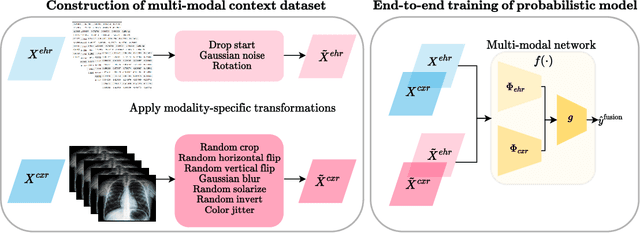


Abstract:Machine learning-aided clinical decision support has the potential to significantly improve patient care. However, existing efforts in this domain for principled quantification of uncertainty have largely been limited to applications of ad-hoc solutions that do not consistently improve reliability. In this work, we consider stochastic neural networks and design a tailor-made multimodal data-driven (M2D2) prior distribution over network parameters. We use simple and scalable Gaussian mean-field variational inference to train a Bayesian neural network using the M2D2 prior. We train and evaluate the proposed approach using clinical time-series data in MIMIC-IV and corresponding chest X-ray images in MIMIC-CXR for the classification of acute care conditions. Our empirical results show that the proposed method produces a more reliable predictive model compared to deterministic and Bayesian neural network baselines.
Privacy-preserving machine learning for healthcare: open challenges and future perspectives
Mar 27, 2023Abstract:Machine Learning (ML) has recently shown tremendous success in modeling various healthcare prediction tasks, ranging from disease diagnosis and prognosis to patient treatment. Due to the sensitive nature of medical data, privacy must be considered along the entire ML pipeline, from model training to inference. In this paper, we conduct a review of recent literature concerning Privacy-Preserving Machine Learning (PPML) for healthcare. We primarily focus on privacy-preserving training and inference-as-a-service, and perform a comprehensive review of existing trends, identify challenges, and discuss opportunities for future research directions. The aim of this review is to guide the development of private and efficient ML models in healthcare, with the prospects of translating research efforts into real-world settings.
Deterioration Prediction using Time-Series of Three Vital Signs and Current Clinical Features Amongst COVID-19 Patients
Oct 12, 2022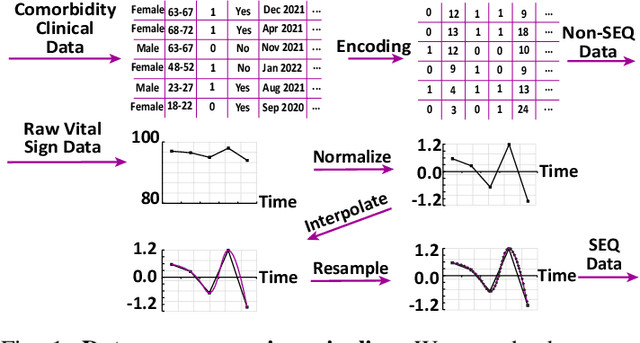
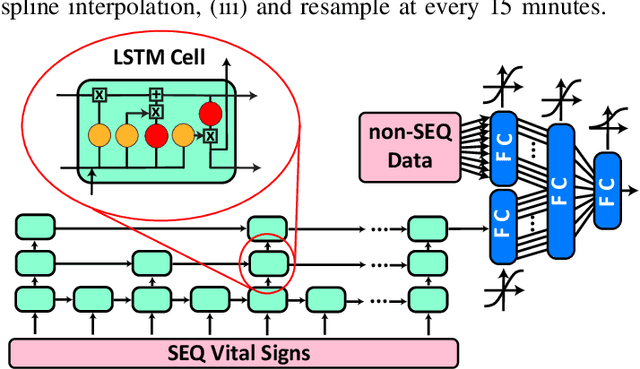
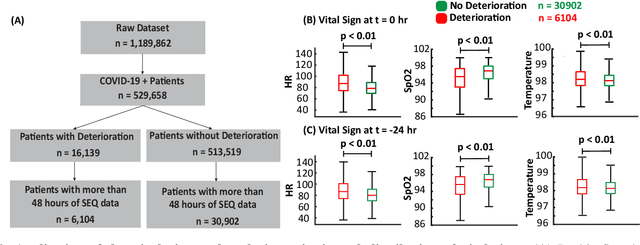
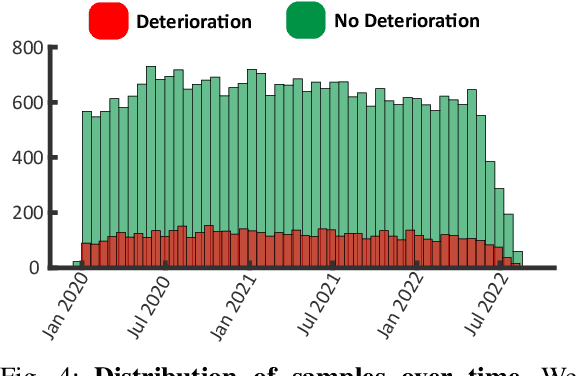
Abstract:Unrecognized patient deterioration can lead to high morbidity and mortality. Most existing deterioration prediction models require a large number of clinical information, typically collected in hospital settings, such as medical images or comprehensive laboratory tests. This is infeasible for telehealth solutions and highlights a gap in deterioration prediction models that are based on minimal data, which can be recorded at a large scale in any clinic, nursing home, or even at the patient's home. In this study, we propose and develop a prognostic model that predicts if a patient will experience deterioration in the forthcoming 3-24 hours. The model sequentially processes routine triadic vital signs: (a) oxygen saturation, (b) heart rate, and (c) temperature. The model is also provided with basic patient information, including sex, age, vaccination status, vaccination date, and status of obesity, hypertension, or diabetes. We train and evaluate the model using data collected from 37,006 COVID-19 patients at NYU Langone Health in New York, USA. The model achieves an area under the receiver operating characteristic curve (AUROC) of 0.808-0.880 for 3-24 hour deterioration prediction. We also conduct occlusion experiments to evaluate the importance of each input feature, where the results reveal the significance of continuously monitoring the variations of the vital signs. Our results show the prospect of accurate deterioration forecast using a minimum feature set that can be relatively easily obtained using wearable devices and self-reported patient information.
MedFuse: Multi-modal fusion with clinical time-series data and chest X-ray images
Jul 14, 2022



Abstract:Multi-modal fusion approaches aim to integrate information from different data sources. Unlike natural datasets, such as in audio-visual applications, where samples consist of "paired" modalities, data in healthcare is often collected asynchronously. Hence, requiring the presence of all modalities for a given sample is not realistic for clinical tasks and significantly limits the size of the dataset during training. In this paper, we propose MedFuse, a conceptually simple yet promising LSTM-based fusion module that can accommodate uni-modal as well as multi-modal input. We evaluate the fusion method and introduce new benchmark results for in-hospital mortality prediction and phenotype classification, using clinical time-series data in the MIMIC-IV dataset and corresponding chest X-ray images in MIMIC-CXR. Compared to more complex multi-modal fusion strategies, MedFuse provides a performance improvement by a large margin on the fully paired test set. It also remains robust across the partially paired test set containing samples with missing chest X-ray images. We release our code for reproducibility and to enable the evaluation of competing models in the future.
 Add to Chrome
Add to Chrome Add to Firefox
Add to Firefox Add to Edge
Add to Edge